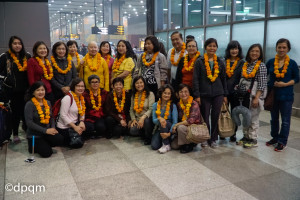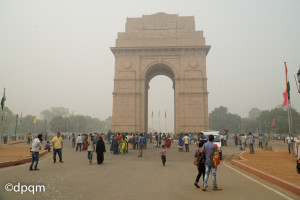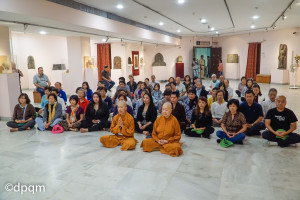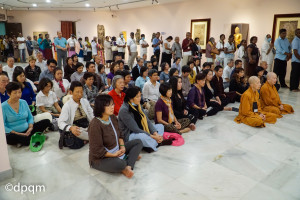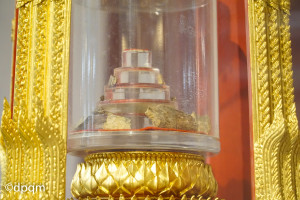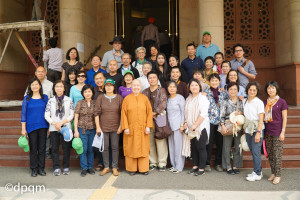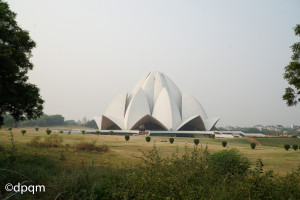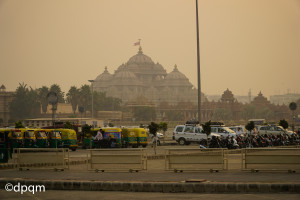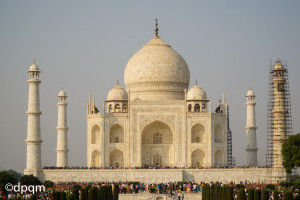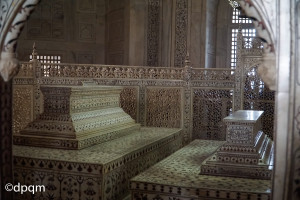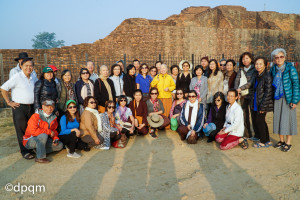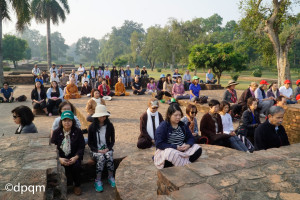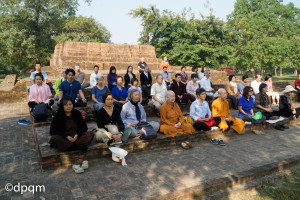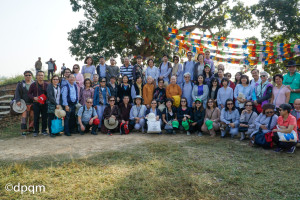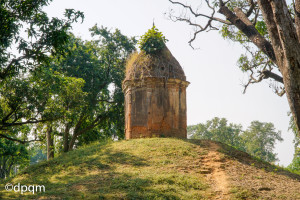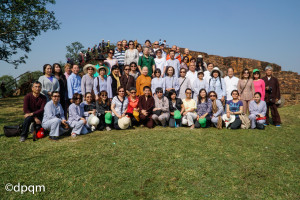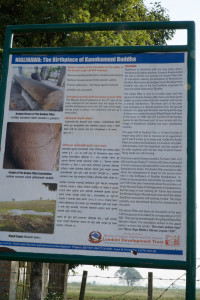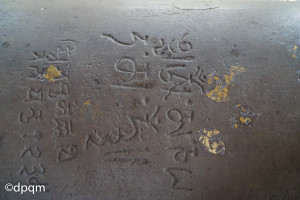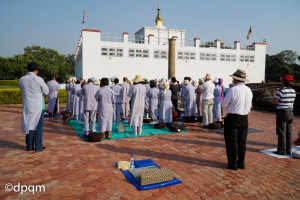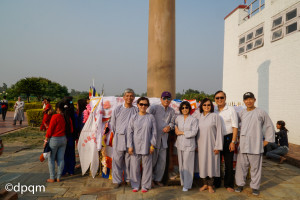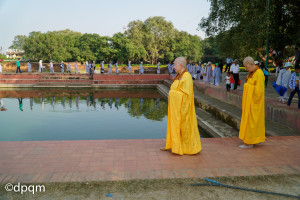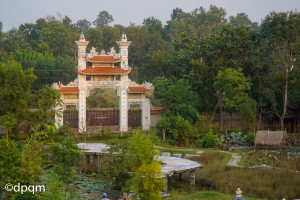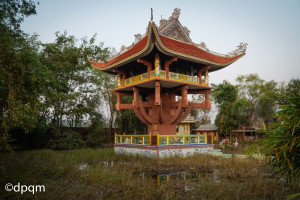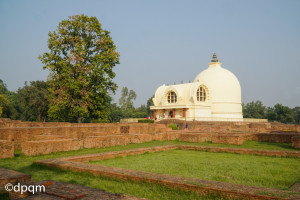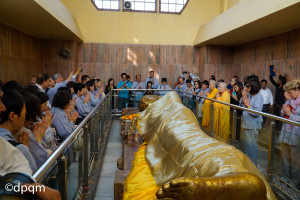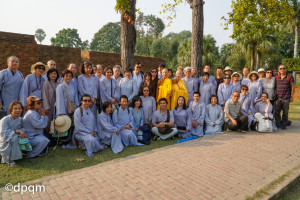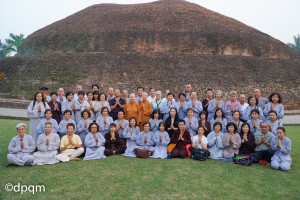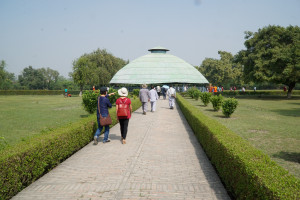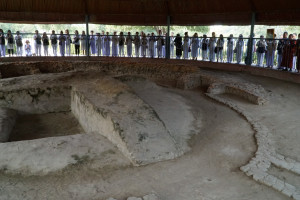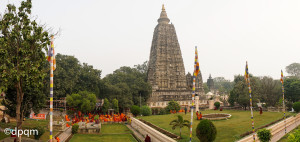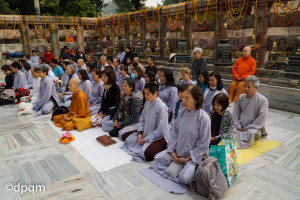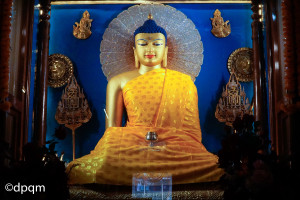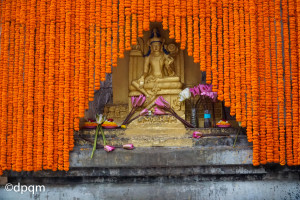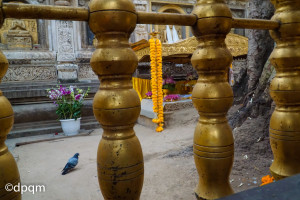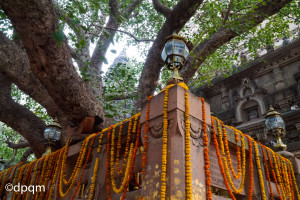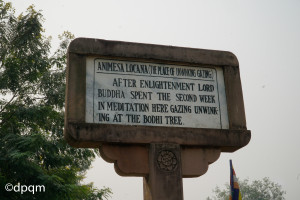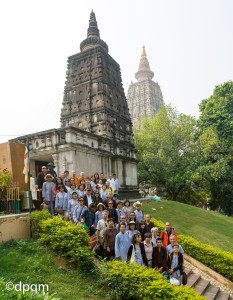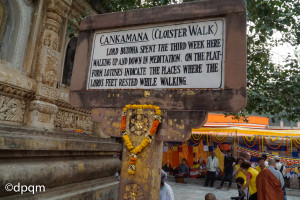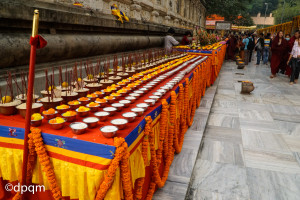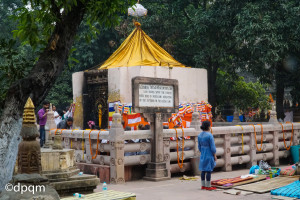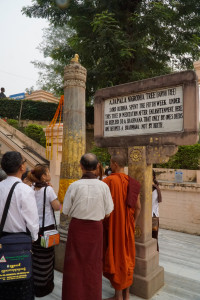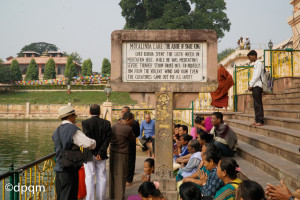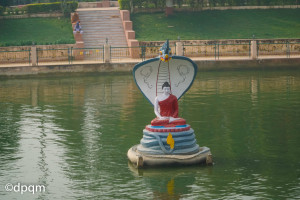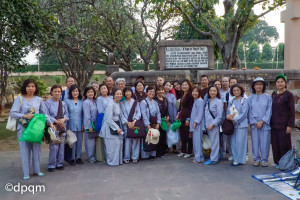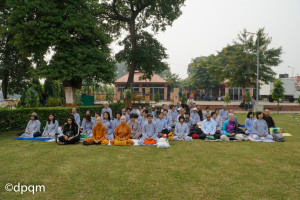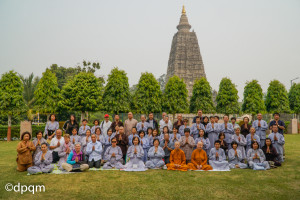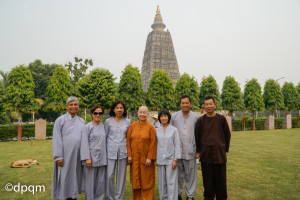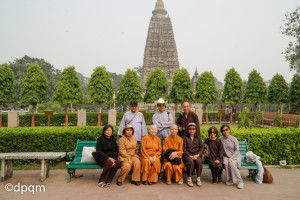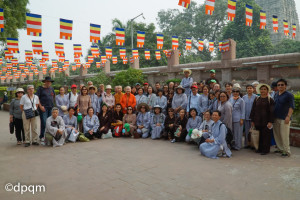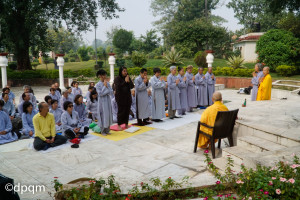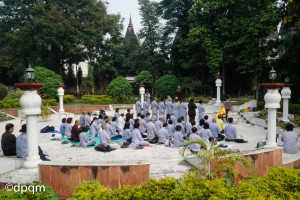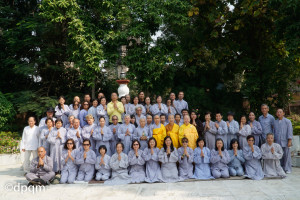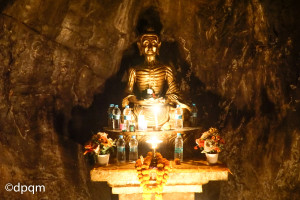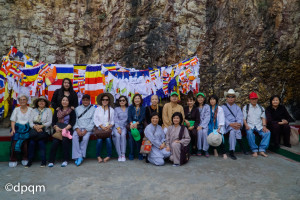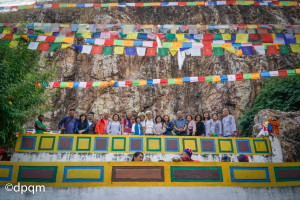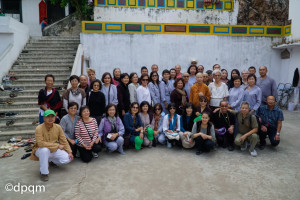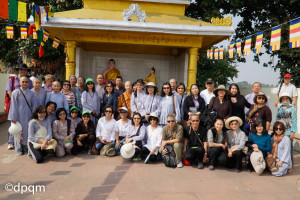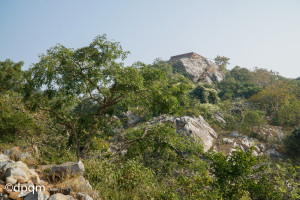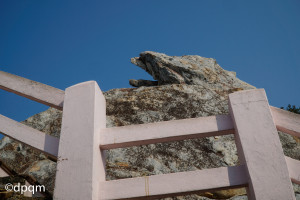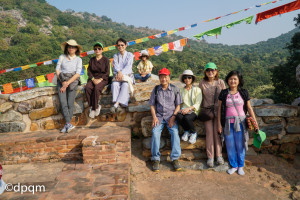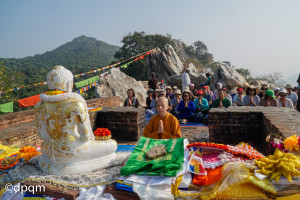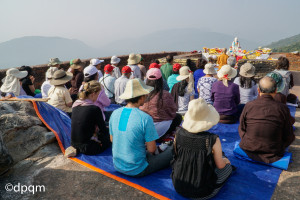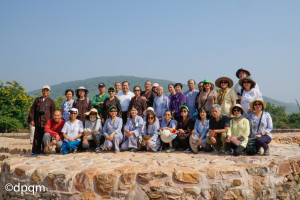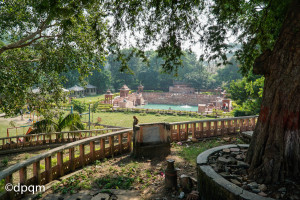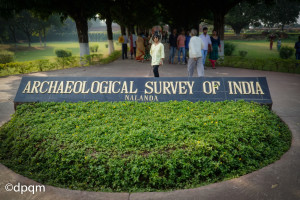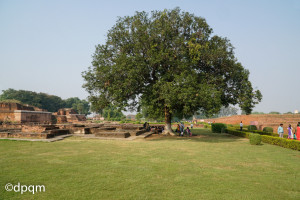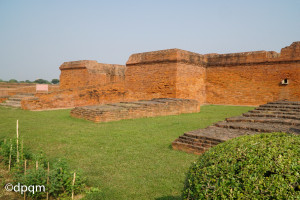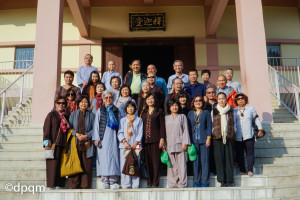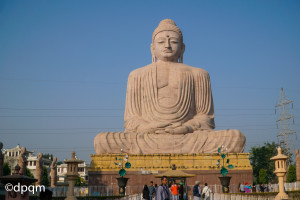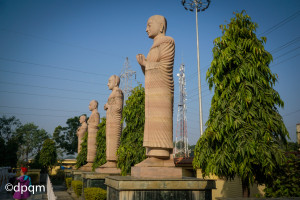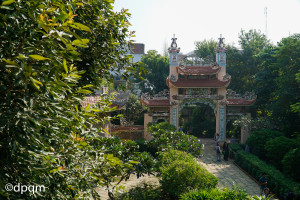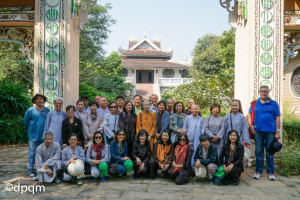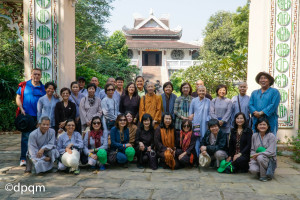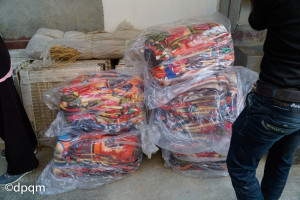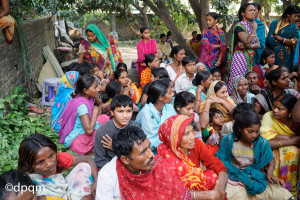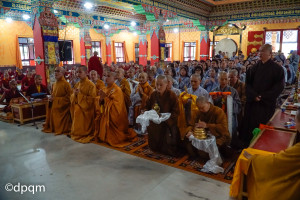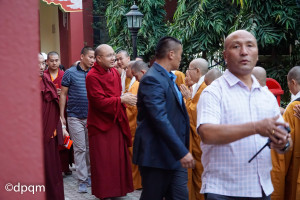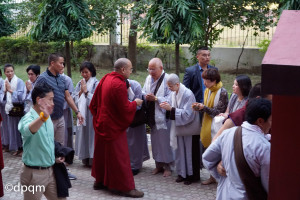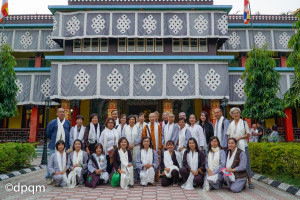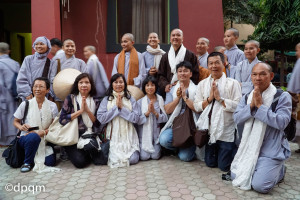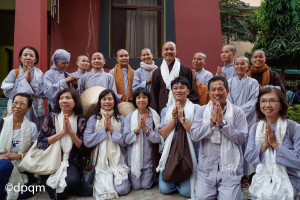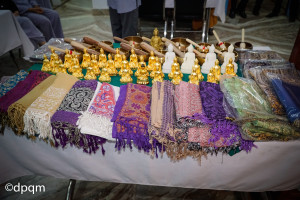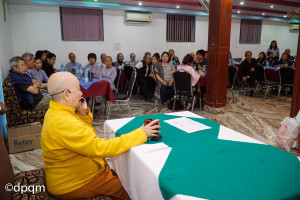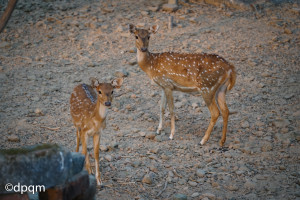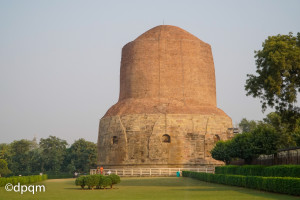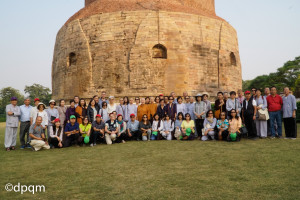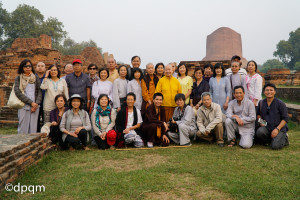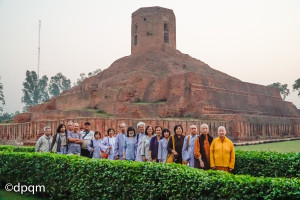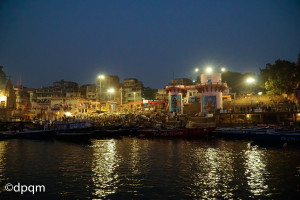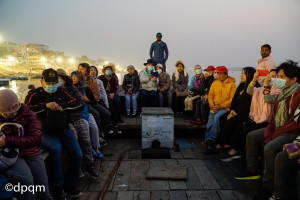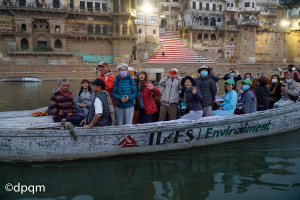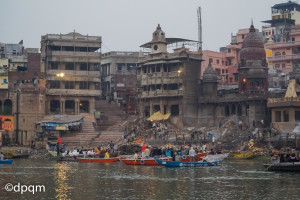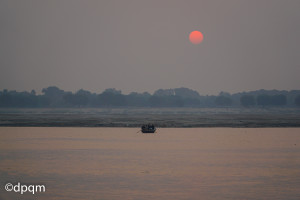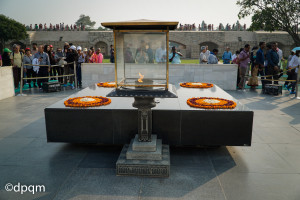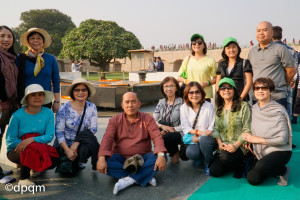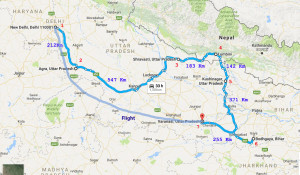2016 Pilgrimage to Buddhist Holy Sites in India and Nepal
Translated from Vietnamese
Excerpts from a report by: Tuệ Chiếu
Photos by: Tuệ Chiếu (Southern California Practice Community)
Introduction
This pilgrimage to Buddhist holy sites in India and Nepal was the seventh organized by Sunyata Meditation, but the first led by Bhikkhuni Triệt Như. The first six editions – in November 2000, November 2004, November 2006, November 2007, February-March 2010, and January 2011 – were all led by Founding Master Thích Thông Triệt.
Bhikkhuni Triệt Như had two main objectives for this seventh pilgrimage:
- To create favorable opportunities for students to practice at Bodh Gaya the topics covered in the Fundamental Meditation course through to the Intermediate Meditation courses and visit the Buddhist holy sites to consolidate their determination to follow the spiritual path.
- To help students clearly recognize the beneficial impact of the Buddha’s teaching on their body, mind and spiritual development through their direct practice of the teaching.
Itinerary of the pilgrimage
The delegation consisted of 67 students gathered from Switzerland, France, Canada, Australia and the USA. The delegation was divided into two groups: a group of 33 led by Mr. Tuệ Vinh, from Southern California, and a second group of 34 led by Mr. Quang Thông, from Sydney.
Click on photos to enlarge
Figure 1: Part of the delegation arriving at New Delhi airport
The first item, on the morning of November 2nd, was a visit to India Gate, a monument commemorating the 82,000 Indian soldiers who gave their lives in the wars from 1914 to 1921.
Figure 2: India Gate
Students were then transported to the National Museum in New Delhi where relics of the Buddha displayed. Bhikkhuni Triệt Như and all students sat down in meditation in the relics chamber. The peacefulness that emanated from the group seemed to pervade other visitors of the museum.
Figure 3: Sitting meditation near the display of relics of the Buddha
Figure 4: Sitting meditation near the display of relics of the Buddha
Figure 5: Relics of the Buddha displayed at the National Museum in New Delhi
Figure 6: Group photo at the National Museum in New Delhi
After lunch, the delegation visited a number of temples in the city of New Delhi such as the Lotus Temple of the Baha’i faith and famous Hindu Akshardham temple. This latter temple was built with marble from Italy and pink sandstone from the deserts of Northwestern India. It has 234 columns and 9 stupas, and includes architectural features such as the Hall of Values, a musical fountain, and a lotus flower-shaped lawn.
Figure 7: Lotus Temple
Figure 8: Akshardham Temple
On November 3rd, the delegation left New Delhi for Agra and a visit to the Taj Mahal. The Taj Mahal was built over 22 years, from 1632 to 1653, and was listed by UNESCO as a World Heritage site in 1983. It combined the architectural styles of Persia, Turkey and India and was built by King Shah Jahan for his Queen Mumtaz Mahal who died at the age of 40.
Figure 9: Taj Mahal
Figure 10: Sarcophagi of King Shah and Queen Mumtaz
November 5th was a day of travel from Agra to Shravasti (Sanskrit: Śrāvastī, Pāli: Sāvatthī). In the days of the Buddha, Sāvatthī was the capital of the kingdom of Kosala which was then ruled by King Pasenadi. At Shravasti, the delegation visited the location of the Jetavana, the monastery (vihāra) that the generous merchant Anāthapindika and Prince Jeta donated to the Buddha, and in particular the place where the Buddha resided while at Jetavana, the bodhi tree of Ānanda, the octagonal well where the Buddha drew water, and the foundations of the old dwelling rooms. There, Bhikkhuni Triệt Như introduced the delegation to the story of the arahat disciple of the Buddha named Sīvali who had accumulated so many merits that anyone coming near him would enjoy good fortune. Close to the Jetavana are two stupas: the Pakki Kuti that marks the place where the Buddha converted the terrifying bandit Angulimala, and the Kacchi Kuti that marks the home of Anāthapindika. On the way to Shravasti, the delegation stopped at Sankasya which is the place where the Buddha was said to have returned to this world three months after his passing to give a sermon to Queen Maya and heavenly devas. In the afternoon, the delegation continued the journey toward Nepal.
Figure 11: Rocky mount at Jetavana
Figure 12: Sitting meditation at Jetavana
Figure 13: Sitting meditation at Jetavana
The morning of November 6th, the delegation visited Kapilāvatthu, situated in Nepal approximately 70 km from the border with India. The brick foundations of the West Gate of the city are still visible and signs were erected by archeologists to mark specific locations. About a kilometer from the West Gate is the location of the East Gate, which was the gate through which Prince Siddhattha silently left the city in search for the path to liberation. In the south western direction at the Nigrodha grove near the village of Kudan is the place where King Suddhodana met the Buddha after 13 years of separation. There is an ancient stupa that marks the place where Rahula undertook the renunciation ceremony.
Figure 14: The East Gate
Figure 15: Ancient stupa marking the place where Rahula undertook the renunciation ceremony
Figure 16: Place where King Suddhodana met the Buddha after 13 years of separation
Nearby is a small village named Nigalihawa. It is the reputed birthplace of Konagamana (Sanskrit: Kanakamuni) Buddha, the fifth of the seven ancient Buddhas mentioned by the Buddha (Sakkamuni Buddha). In 1899, a stone column erected by King Asoka at this location was unearthed. The top part of the column was five meters long, and the bottom part one meter long. The top part of the stone column had a Tibetan inscription that includes the mantra “Om Mani Padme Hum” together with a carving of two peacocks. The bottom part of the column had a Brahmi (an ancient Indian dialect) inscription about the visit of King Asoka to Kapilāvatthu.
Figure 17: Marking commemorating the birth place of Konagamana Buddha
Figure 18: Inscription “Om Mani Padme Hum”
On November 7th, the delegation visited Lumbini, the birth place of the Buddha. The holy sites there included the brick paving of the temple where Prince Siddhattha was born, the pond where Queen Maya bathed her newborn son, and the stone column erected by King Asoka. The delegation paid respect and sat in meditation on the brick paving under a bodhi tree, then walked in meditation around the pond. Next was a visit to the Vietnamese Bồ Đề Phật Quốc pagoda whose abbot is the venerable Huyền Diệu.
Figure 19: Lumbini, birth place of the Buddha
Figure 20: Stone column erected by King Asoka at Lumbini
Figure 21: Walking meditation around the pond at Lumbini
Figure 22: Vietnamese pagoda Bồ Đề Phật Quốc at Lumbini
Figure 23: Replica of the Vietnamese One Pillar Pagoda inside Bồ Đề Phật Quốc pagoda
The following day, November 8th, the delegation travelled to Kushinagar. In the days of the Buddha, Kushinagar (Kusinara) was the capital of the kingdom of Mala. Nowadays, it is a village of the Kushinagar district in the Indian state of Uttar Pradesh, near the border with Nepal. The site where the Buddha passed from this world was only discovered in 1876. A 6.1 meter statue of a lying Buddha was also found there. The stupa and temple that we can see today were built in 1956. Inside the temple there is a statue representing the Buddha when he left the world, lying on his right side, with his head toward the North. The statue is placed on a stone pedestal, which has at the front an inscription dating it to the fifth century CE. The statue was originally made of bronze, but successive pilgrims have added gilded coatings to it. The delegation also visited the place that commemorates the incineration of the body of the Buddha.
Figure 24: Kushinagar, where the Buddha passed from this world
Figure 25: Statue representing the position of the Buddha when he left the world
Figure 26: Group photo near the two sāla trees
Figure 27: Mount commemorating the place where the Buddha’s body was incinerated
On the way back, the delegation visited one of the original eight stupas that contained the relics of the Buddha, belonging to the Lichhavi clan at Vaishali (P: Vaiśālī). This stupa was discovered in 1958. The relics and ancient artifacts found there were transferred to the National Museum in New Delhi. The delegation then left Nepal and re-entered India, arriving at Bodh Gaya at about 5:30pm.
Figure 28: Site where the relics of the Buddha were kept by the Lichhavi clan
Figure 29: Remnants of the place where the Lichhavi clan kept the relics of the Buddha
Among the four Buddhist holy sites, also called the “Four Places that Produce Enthusiasm”, Bodh Gaya is the place that attracts the most pilgrims. It is crowded at all times, filled with Buddhist monks, nuns and lay people from around the world. We can see representation of all the schools of Buddhism there. Even on days when there is no official ceremony, Bodh Gaya is not a quiet place. Every day, there are monks and nuns reciting suttas or chanting mantras using loud speakers. The sound of sutta recitation and mantra chanting can be heard clearly by everyone around the site. The Great Enlightenment (Mahabodhi) Stupa is the architectural monument that commemorates the place where the Buddha sat in meditation and attained the ultimate enlightenment. Bodh Gaya was said to be a unique sacred place destined to welcome the coming of the great enlightened being. According to legend, the bodhi tree had started to grow there from the time when the future Sakkamuni Buddha was born. Before that time, Bodh Gaya was a flat sandy area where no trees could grow. About two hundred and fifty years after the passing of the Buddha, King Asoka visited the place where the Buddha attained enlightenment and erected the Great Stupa. In 2002, the great Mahabodhi stupa, built with many previous stones to a height of 50 meters was listed by UNESCO as a world heritage site.
Figure 30: The Great Stupa at Bodh Gaya
Figure 31: Sitting meditation before the main altar at Bodh Gaya
Figure 32: Statue of the Buddha inside the Great Stupa at Bodh Gaya
Figure 33: Statue to Avalokiteśvara Bodhisattva outside the Great Stupa
Figure 34: The Diamond Pedestal at Bodh Gaya
The bodhi tree that now grows to the west of the Great Stupa is a graft from a bodhi tree that grows in Sri Lanka. The bodhi tree in Sri Lanka is called the Sri Mahabodhi tree and is said to have originated from a graft of the original bodhi tree that was brought there by the daughter of King Asoka. The Diamond Pedestal, which is said to mark the exact spot of the original bodhi tree, is one of seven markings that King Asoka erected to commemorate events that occurred over seven weeks following the Buddha’s enlightenment. It corresponds to the first week and commemorates the week that the Buddha spent sitting under the bodhi tree to re-experience the bliss of enlightenment.
Figure 35: The bodhi tree at Bodh Gaya
On the second week, the Buddha stood a distance from the bodhi tree and gaze at it without blinking for a whole week in order to express his gratitude toward the tree for having sheltered him from sun and rain during the whole period when he sat in meditation until enlightenment.
Figure 36: Monument marking the place where the Buddha stood and gazed at the bodhi tree
Figure 37: Group photo at the place where the Buddha stood and gazed at the bodhi tree
On the third week, as the Buddha was still staying around the bodhi tree, heavenly devas had doubts whether he had attained enlightenment. The Buddha could hear these thoughts of the heavenly devas and used his supernatural powers to create a jeweled covered promenade (ratana cankamana) and practiced walking meditation on it for a whole week.
Figure 38: Monument marking the place where the Buddha walked in meditation
Figure 39: Place where the Buddha walked in meditation in the third week
On the fourth week, the Buddha realized the Law of Dependent Origination. His body and mind became absolutely pure and emitted a six-colored aura. The six colors are: blue (nīla), yellow (pīta), crimson (lohita), white (odāta), and scarlet (māñjesṭṭha) with the sixth color being the combination (prabhāsvara) of the other five colors. The current Buddhist flag uses these six colors. The roofless Jeweled House (Ratanaghara) commemorates the event on the fourth week.
Figure 40: The roofless Jeweled House commemorating the fourth week
On the fifth week, the Buddha sat beneath the ajapāla tree and relived the Bliss of Emancipation (vimutti sukha). At the end of the week, when he exited this transcendental state, a conceited (huhumka jākita) Brahmin approached, and after customary salutations, asked him: “O venerable Gotama, to what extent is one worthy of being called a brāhmaṇa (Brahmin priest) and what are the conditions that make a brāhmaṇa?”
The Buddha replied in verses that a person who has discarded evil; is without conceit; free from defilements; self-controlled; versed in knowledge of the Vedas; who has led the holy life; speaks the right dhamma; and is free of conceit in all circumstances is worthy to be called a brāhmaṇa. (Khuddaka Nikāya, “The Shorter Discourses of the Buddha”, Udāna 3).
King Asoka erected a stupa to commemorate this event. This stupa faces the Great Stupa and stands about 65 meters from the bodhi tree.
The ajapāla tree was also the site where, two weeks later, the Buddha accepted the request by Brahmā deity Sahampati to teach the dhamma. This acceptance followed a period when the Buddha was reluctant to teach the dhamma that he had just realized as it was so deep, profound and beyond the reasoning of common people.
Figure 41: Place where the Buddha expounded on what makes a person worthy of being called a brāhmaṇa
In the sixth week, the Buddha moved from the ajapāla tree to the Mucalinda Lake and stayed there a week to relive the Bliss of Emancipation. Suddenly, a storm gathered. The sky darkened under heavy clouds and a cold wind blew for several days. At that moment, Mucalinda, the king snake, came out of his burrow, wrapped himself seven times around the Buddha’s body and placed his hood over the head of the Buddha to protect him from the rain. At the end of the seventh day, when the storm had cleared, Mucalinda freed himself from his snake form to reappear as a young man. He clasped his hands and paid respect to the Buddha. The Buddha said the following verses:
“There is happiness and detachment for the one who is satisfied,
Who has heard the Dhamma, and who sees,
There is happiness for he who is free from ill-will in the world,
Who is restrained towards breathing beings.
The state of dispassion in the world is happiness,
The complete transcending of sense desires,
(But) for he who has removed the conceit ‘I am’
– this is indeed the highest happiness.”
(Khuddaka Nikāya, “The Shorter Discourses of the Buddha”, Udāna 10)
Figure 42: Place where the Buddha met the sacred snake Mucalinda
Figure 43: Statue of the Buddha and the sacred snake Mucalinda
On the seventh week, the Buddha moved over to the rajāyatana tree. A stone inscription marks this location. Two merchants from Burma (now Myanmar) were on their way home when they stopped by the place where the Buddha meditated and took refuge in the Buddha and his dhamma (Bhuddam Saranam Gacchhāmi, Dhammam Saranam Gachhāmi). This is the first instance of lay persons taking refuge in the Two Jewels as the third Jewel, the Sangha, did not exist at the time. The two merchants made to the Buddha an offering of rice cakes mixed with honey. At their request for a relic, the Buddha pulled some of his hair and offered it to them. The two merchants took the hair back to Burma. It is now kept in the Shevadagon temple in Rangoon (now Yangon) as a sacred relic.
The Buddha then moved from the rajāyatana tree back to the ajapāla tree. The Buddha sat on a rock and relived the truths that he had realized. He was reluctant to teach them. At that moment Brahmā deity Sahampati appeared and appealed to the Buddha to teach the dhamma.
Figure 44: Place where the Buddha met the two Burmese merchants
The delegation stayed from November 9th to November 16th at Bodh Gaya. Every day, the group had three meditation sessions of one hour each, at 5:30am, 9am and 3pm. In addition, students may practice further or visit the holy sites.
Figure 45: Sitting meditation at Bodh Gaya
Figure 46: Group photo at Bodh Gaya
Figure 47: The Southern California group
Figure 48: The Houston group
Figure 49: The whole delegation at Bodh Gaya
On November 11th, at Bodh Gaya, Bhikkhuni Triệt Như officiated the Temporary Renunciation ceremony for three students and the Taking Refuge in the Three Jewels ceremony for 11 students.
Figure 50: Taking Refuge in the Three Jewels ceremony at the meditation garden
Figure 51: Taking Refuge in the Three Jewels and Temporary Renunciation ceremonies at the meditation garden
Figure 52: Group photo at the meditation garden
On November 13th the delegation travelled to the Self Mortification Forest where the Buddha practiced self-mortification for 6 years. In the area were also the village of Sujāta and the Sujāta stupa that commemorates the place where the Buddha was offered a bowl of sheep milk by Sujāta after he had collapsed unconscious from his self-mortification practice. The delegation also visited the remnants of the home of Sujāta.
Figure 53: Statue of the Buddha practicing self-mortification
Figure 54: Group photo at the Self-Mortification Forest
Figure 55: Group photo at the Self-Mortification Forest
Figure 56: Group photo at the Self-Mortification Forest
Figure 57: Group photo at the place where Sujāta offered the Buddha the bowl of sheep milk
On November 14th, the delegation travelled to the Vulture’s Peak. The Vulture’s Peak, now known as Gridhakuta Hill, is a small hill of about 80 meters in height among a group of hills in that area. The Buddha resided in several places around Rājagaha for about 12 years, but he mostly resided at the Vulture’s Peak and delivered many sermons there. Near the top of the Vulture’s Peak are several caves where the great disciples of the Buddha such as Mahā Kassapa, Sāriputta and Ānanda resided and practiced. The chair lift going to the top of the Ratna Mountain, a hill next to the Vulture’s Peak, offered views of a Japanese temple. On the way back from the Vulture’s Peak, the delegation visited the jail where King Bimbisāra was held, and the remnants of the foundations of the surgery built by Jivaka, the personal surgeon of King Bimbisāra and surgeaon of the Sangha. Also on the way back, the delegation visited a hot spring which the Buddha mentioned in several sermons. Perhaps the Buddha might have bathed in this hot spring? Buddhist texts mention a Buddhist temple named Tapodārāma near this hot spring, but this temple no longer exists and has been built over by Hindu temples. Hindu temples have often been built on Buddhist holy sites to attract the faith of the population.
Figure 58: The Vulture’s Peak
Figure 59: Rock formation resembling a vulture’s head
Figure 60: At the top of the Vulture’s Peak
Figure 61: Reciting the Heart Sūtra at the top of Vulture’s Peak
Figure 62: Sitting meditation at the top of the Vulture’s Peak
Figure 63: Group photo at the top of the Vulture’s Peak
Figure 64: Hot spring mentioned by the Buddha and where he may have bathed
On November 15th, the delegation visited the Nalanda University. Nalanda is the name of an ancient university situated in the state of Bihar, India, about 55 miles to the South East of Patna, the capital of Bihar. It was a center of Buddhist education from 427 to 1197 CE and is considered the first great university in human history. In 1193, Nalanda was destroyed by a Turkish army led by General Bakhtiya Khilji. Historians considered this event as marking the decline of Buddhism in India. The Persian historian Minhaj mentioned in his text Tabaquat-I-Nasini that thousands of Buddhist monks were burn alive while thousands more were decapitated in Khilji’s effort to eradicate Buddhism and sow the seeds of Islam through the might of the sword. The burning of books from the Nalanda library lasted for months and the smoke obscured the low lying hills around Nalanda.
Toward the end of the 19th century, the archeologist Alexander Cunningham discovered the remnants of Nalanda near the village of Baragaon. Excavations were conducted by Indian archeologists around 1915-1937 and more recently in 1974-1982. All what is left of Nalanda are some brick foundations and an old wall.
On the same day, the delegation visited several pagodas located at Bodh Gaya, including the Vietnamese National Pagoda, and pagodas from Burma (now Myanmar), Japan and Thailand.
Figure 65: Entrance to the Nalanda archeological site
Figure 66: Brick foundations that remained from Nalanda
Figure 67: Ancient walls of Nalanda
Figure 68: Group photo taken in front of the Tibetan pagoda
Figure 69: Statue of Buddha at the Japanese pagoda
Figure 70: Statues of the ten great disciples of the Buddha
Figure 71: Three-door entrance gate to the Vietnam National Pagoda
Figure 72: Group photo in front of the Vietnam National Pagoda
Figure 73: Group photo in front of the Vietnam National Pagoda
On November 17th, the delegation made donations to 250 poor families at the village of the tour guide.
Figure 74: Donation of blankets
Figure 75: Donation of blankets and rice flour to local families
The delegation then visited the Tibetan Tergar Monastery. There the delegation had the good fortune of meeting the pilgrimage delegation led by Venerable Pháp Hòa. Together the two delegations paid respect to the 17th Karmapa, leader of the Karma Kagyu School.
Figure 76: Vietnamese pilgrims paying respect
Figure 77: The Karmapa greeting members of the Sangha
Figure 78: The Karmapa greeting each member of the delegation
Figure 79: Group photo in front of the Tergar Monastery
Figure 80: Group photo at Tergar Monastery with Venerable Pháp Hòa
Figure 81: Group photo at Tergar Monastery with Venerable Pháp Hòa
At the end of the day, Bhikkhuni Triệt Như created the opportunity for all members of the delegation to reflect on the trip and discuss any spiritual benefits that they have attained in the last 17 days.
Figure 82: Presents from Bhikkhuni Triệt Như to delegates
Figure 83: Bhikkhuni Triệt Như summarizing the 17 days of pilgrimage
On November 18th, the delegation visited the Deer Park where the Buddha set the dhamma wheel in motion by giving the first sermon to the group of five monks led by Koṇḍañña. The Deer Park is situated next to Sarnath and approximately 12 km to the North East of Varanasi. In the days of the Buddha, two thousand and five hundred years ago, this was a verdant and picturesque forest where many deer lived. In the Pāli texts, Sarnath was called Migadaya (Deer Park). It was a place frequented by many famous holy men (Pāli: isi) and was therefore called Isipatana (“the place where holy men landed”).
Figure 84: The Deer Park
Figure 85: Monument commemorating the place where the Buddha set the dhamma wheel in motion
Figure 86: Group photo at the Deer Park
Figure 87: Group photo at the Deer Park
Figure 88: Group photo at the Deer Park
On November 19th, the delegation visited Varanasi (Benares). Also called “The Eternal City”, Varanasi is a large city of about 1 million people in the State of Uttar Pradesh in mid-northern India. Varanasi is most famous as a spiritual center for over 2500 years. For Hindu people, this is the ideal place to leave this world as they believe that this is the only gate that leads to the heavenly realm.
The Ganges River is most beautiful at dawn. We watched the sun rise over the Ganges River. It was foggy and a little chilly on that day. Even at the early hours of dawn, many tourists had come out the watch the sunrise. Many small boats had left their mooring gate to move along the river. We saw a funeral pyre still burning with its white smoke filling a portion of the space over the river. The delegation left Varanasi to catch the flight back to New Delhi.
Figure 89: Varanasi, the Eternal City of Indian people
Figure 90: On the Ganges River
Figure 91: At dawn on the Ganges River
Figure 92: A funeral pyre on the banks of the Ganges River
Figure 93: Sunrise over the Ganges River
On the morning of November 20th, the delegation visited the tomb of Mahatma Gandhi before leaving India and end the 20-day pilgrimage.
Figure 94: Tomb of Mahatma Gandhi
Figure 95: Group photo at the tomb of Mahatma Gandhi
The pilgrimage to Buddhist holy sites plays an important role in the spiritual development of Buddhist practitioners as it nourishes the strong faith in the Three Jewels. The Buddha himself, in the Mahā-Parinibbāna Sutta (“The Discourse on the Great Emancipation”) encouraged his disciples to visit at least once the four sites that played an important role in his life. The pilgrimage is also an opportunity for all of us to deeply reflect on the life of the Buddha and the precious teaching that he left. Students are able to see clearly the benefits on their body, mind and spiritual development when they practice by themselves in accordance with the teaching of the Buddha.
Figure 96: Itinerary of the 2016 Pilgrimage trip.
